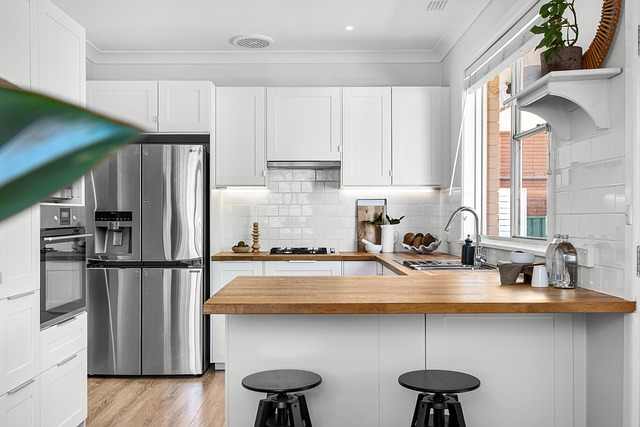Upgrading your kitchen with a focus on sustainability significantly reduces environmental impact. Choose green alternatives like reclaimed wood, recycled glass countertops, and energy-efficient appliances for an eco-friendly makeover. Sustainable cabinetry, flooring, and countertops from rapidly renewable or upcycled materials blend style and durability. These smart design choices not only benefit the planet but also create a beautiful home while offering long-term cost savings. Incorporate low-VOC paint, water-conserving fixtures, and recycled kitchen cabinets for an eco-conscious kitchen renovation that aligns with current trends.
Looking to refresh your kitchen while minimizing environmental impact? Discover ethical and low-impact updates that blend style with sustainability. From choosing eco-friendly materials like recycled countertops and sustainable cabinetry to designing energy-efficient spaces, this guide empowers you to create a greener kitchen. Learn about the latest in low-VOC paint, water conservation measures, and waste reduction strategies for an eco-conscious remodel. Embrace a future-forward kitchen that benefits both your home and the planet.
- Choosing Sustainable Kitchen Materials
- – Overview of eco-friendly and recycled kitchen materials
- – Benefits of sustainable cabinetry, countertops, and flooring
- – Where to source green materials
Choosing Sustainable Kitchen Materials
When considering an eco-friendly kitchen makeover, selecting sustainable materials is a key step towards reducing your environmental impact. Opting for green alternatives in your kitchen design can make a significant difference, from the countertops to the cabinetry and even the appliances. Sustainable kitchen ideas include choosing recycled materials like reclaimed wood or recycled glass countertops, which not only lessen waste but also offer unique, natural aesthetics.
Eco-friendly kitchen remodeling goes beyond looks; it’s about making energy-efficient choices too. You can achieve this by opting for low-VOC finishes and selecting appliances with excellent energy ratings. Sustainable cabinetry, for instance, is now made from rapidly renewable resources or upcycled materials, ensuring your new kitchen cabinets align with green kitchen renovation goals while still being stylish and durable. These thoughtful selections contribute to a healthier planet and a more beautiful, harmonious home.
– Overview of eco-friendly and recycled kitchen materials
When considering an ethical and low-impact kitchen update, turning to eco-friendly materials is a powerful step towards sustainability. Sustainable kitchen design encompasses a wide range of options, from recycled countertop materials like recycled glass or engineered wood products made from reclaimed wood to sustainable cabinetry crafted from bamboo or other fast-growing resources. These choices not only reduce waste but also minimize the carbon footprint associated with traditional manufacturing processes.
An eco-friendly kitchen renovation goes beyond cabinets and countertops; it includes energy-efficient appliances, low-VOC (volatile organic compound) paint, and faucet fixtures designed to conserve water. Incorporating these green kitchen renovation ideas not only contributes to environmental preservation but also offers long-term savings on utility bills. By choosing recycled kitchen materials and implementing energy-efficient solutions, homeowners can create a functional, beautiful, and planet-friendly space.
– Benefits of sustainable cabinetry, countertops, and flooring
Sustainable kitchen design offers a myriad of benefits for both the environment and your home. One of the key advantages is the use of eco-friendly materials, such as recycled or certified sustainable cabinetry, countertops, and flooring. These options reduce the environmental impact by minimizing deforestation (a major concern with traditional wood products) and lowering water consumption in the manufacturing process. For instance, recycled kitchen cabinets made from old newspapers or plastic bottles are an innovative and beautiful way to incorporate green practices into your space.
Furthermore, sustainable cabinetry and countertops often have lower VOC (Volatile Organic Compound) emissions, making them safer for occupants. Energy-efficient appliances paired with these eco-friendly materials contribute to a greener kitchen and can significantly reduce utility costs over time. These simple yet powerful updates are at the forefront of modern kitchen renovations, allowing homeowners to embrace a more sustainable lifestyle without compromising on style or functionality.
– Where to source green materials
When planning an eco-friendly kitchen remodeling project, sourcing green materials is a significant step towards achieving a sustainable kitchen design. Look for suppliers who specialize in recycled and reclaimed materials to reduce your environmental impact. For example, consider sustainable cabinetry made from bamboo or recycled wood, which are both fast-growing and renewable resources. Additionally, explore options like eco-friendly countertops crafted from granite, quartz, or recycled glass, which offer durability and a unique aesthetic without the need for harsh chemicals during production.
Many brands now provide low-VOC (Volatile Organic Compound) finishes and products, ensuring your kitchen is not only energy-efficient but also free from harmful fumes. Incorporating recycled kitchen materials not only reduces waste but also adds character to your space. From floor tiles made from reclaimed materials to faucet fittings crafted from upcycled metals, these options align with the trend of green kitchen renovation while allowing you to create a stylish and functional cooking environment.
Upgrading your kitchen can be an exciting journey towards a more sustainable and ethical home. By choosing eco-friendly materials like recycled countertops, sustainable cabinetry, and green flooring options, you contribute to minimizing waste and reducing your environmental footprint. A low-VOC kitchen remodel ensures a healthier living space for years to come. Remember, every small step towards sustainable kitchen design makes a difference, and these ideas can inspire a beautiful and responsible transformation.
